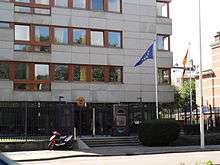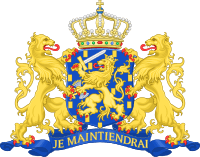Germany–Netherlands relations
German–Dutch relations refer to diplomatic, military and cultural relations between the bordering nations of Germany and the Netherlands. Relations between the modern states started after Germany became united in 1871.[3] Before that the Netherlands had relations with Prussia and other, smaller German-speaking nations.
 | |
Germany |
Netherlands |
|---|---|
| Diplomatic mission | |
| Embassy of Germany, The Hague | Embassy of the Netherlands, Berlin |
| Envoy | |
| Ambassador Franz Josef Kremp[1] | Ambassador Monique van Daalen[2] |

History
During World War I, the German army refrained from attacking the Netherlands, and thus relations between the two states were preserved. At war's end in 1918, the former Kaiser Wilhelm II fled to the Netherlands, where he lived till his death in 1941. The German army occupied the Netherlands during World War II and kept the country under occupation in 1940–1945. Adolf Hitler had considered the Netherlands suitable for annexation within the Greater Germanic Reich, viewing the Dutch as a related Germanic people. During this period, nearly three-quarters of the Dutch Jewish population perished in the Holocaust. Anne Frank was the most famous victim, as her diary survived and was published after the war. [4] The Dutch famine of 1944–45, known in the Netherlands as the Hongerwinter (literal translation: hunger winter), was a famine that took place in the German-occupied Netherlands, especially in the densely populated western provinces north of the great rivers, during the winter of 1944–45, near the end of World War II. A German blockade cut off food and fuel shipments from farm towns. Some 4.5 million were affected and survived thanks to soup kitchens. At least 18-22,000 deaths occurred due to the famine.[5][6][7] The famine was alleviated by the liberation of the provinces by the Allies in May 1945.[8]
Present
Germany has an embassy in The Hague and consuls in Amsterdam, Arnhem, Eindhoven, Enschede, Groningen, Leeuwarden, Maastricht, Noord-Beveland, Rotterdam, while the Netherlands has an embassy in Berlin and consuls in Düsseldorf, Frankfurt, Hamburg, Munich and Stuttgart. Both nations are members of the European Union and NATO.
According to the official website of the Dutch government, relations between the two are currently "excellent", enjoying "close political, economic, social, cultural, administrative and personal ties". Germany is also by far the Netherlands’ main trading partner, both in imports and exports.[9]
Emigration
As of 2017, around 164,000 people with a Dutch migration background resided in Germany.[10]
Country comparison
| Coat of Arms |  |
 |
| Flag |  |
 |
| Population | 82,800,000 | 17,237,700[11] |
| Area | 357,168 km² (137,847 sq mi) | 41,543 km² (16,033 sq mi) |
| Population density | 232/km² (601/sq mi) | 415.1/km² (1,075.1/sq mi) |
| Capital | Berlin | Amsterdam (capital), The Hague (seat of government) |
| Largest city | Berlin – 3,690,000 (6,004,857 Metro) | Amsterdam – 851,573 (2,431,000 Metro) |
| Government | Federal parliamentary republic | Unitary parliamentary constitutional monarchy |
| First Leader | Konrad Adenauer | William I of the Netherlands (monarch), Gerrit Schimmelpenninck (prime minister) |
| Current Leader | Angela Merkel | Willem-Alexander (monarch), Mark Rutte (prime minister) |
| Official languages | German (de facto and de jure) | Dutch |
| Main religions | 57.9% Christianity, 36.2% non-religious, 4.9% Islam, 1.0% other[12] | 50.1% unaffiliated, 23.7% Roman Catholic, 6.5% Dutch Reformed Church, 5.7% Protestant Church in the Netherlands, 3.3% Reformed Churches in the Netherlands, 4.9% Islam, 4.6% other, 0.6% Hinduism, 0.4% Buddhism, 0.1% Judaism[13][14] |
| Ethnic groups | 81.3% German, 3.4% Turkish, 2.3% Polish, 1.5% Russian, 11.5% other | 79.3% Dutch, 6.3% other European, 4.9% Indo, 2.4% Turkish, 2.2% Moroccan-Dutch, 2.1% Surinamese, 0.9% Caribbean, 0.3% Chinese, 0.3% Iraqi, 3.9% other |
| GDP (nominal) | $3.65 trillion[15] | $945.327 billion[16] |
Embassies
The Embassy of Germany is located in The Hague, the Netherlands. The Embassy of the Netherlands is located in Berlin, Germany.
See also
References
- Ambassadeur (in Dutch), Embassy of Germany, The Hague. Retrieved 30 December 2015.
- Ambassadeur Archived 2013-02-03 at the Wayback Machine (in Dutch), Embassy of the Netherlands, Berlin. Retrieved 30 December 2015.
- Amry Vandenbosch, Dutch Foreign Policy since 1815 (1959).
- Rudi Hartmann, "The Anne Frank House in Amsterdam: A museum and literary landscape goes virtual reality." Journalism and Mass Communication 3.10 (2013): 625-644 online.
- "Uitzending Gemist – Vroeger & Zo De hongerwinter – 1944" (video) (in Dutch). Retrieved 21 July 2012.
- van der Zee, Henri A. (1998), The Hunger Winter: Occupied Holland 1944–1945, University of Nebraska Press, pp. 304–05.
- Barnouw, David (1999), De hongerwinter, p. 52, ISBN 9789065504463
- Henri A. Van Der Zee, ed. The Hunger Winter: Occupied Holland, 1944-1945 (U of Nebraska Press, 1998).
- "Bevölkerung in Privathaushalten nach Migrationshintergrund im engeren Sinne nach ausgewählten Herkunftsländern". Statistisches Bundesamt. Retrieved 2019-07-06.
- "Population counter". Centraal Bureau voor de Statistiek. 2017. Retrieved 17 February 2018.
- Numbers and Facts about Church Life in Germany 2016 Report. Evangelical Church of Germany. Retrieved 14 June 2017.
- Schmeets, Hans (2016). De religieuze kaart van Nederland, 2010–2015 (PDF). Centraal Bureau voor der Statistiek. p. 5.
- CBS. "Helft Nederlanders is kerkelijk of religieus". www.cbs.nl (in Dutch). Retrieved 2017-10-17.
- "Report for Selected Countries and Subjects - Gross domestic product, current prices, U.S. dollars". International Monetary Fund.
- "Netherlands". International Monetary Fund. April 2018.,
Further reading
- Jensen, Mette Bastholm. Solidarity in action: A comparative analysis of collective rescue efforts in Nazi-occupied Denmark and the Netherlands (Yale University Press, 2007).
- Kennedy, John R. "Dutch defensive preparations, 1933-1940" (DTIC, Army Command and General Staff College, Fort Leavenworth Ks, 1989) online.
- Leurdijk, J.H. ed. The Foreign Policy of the Netherlands (Alphen aan den Rijn, 1978).
- Maass, Walter B. The Netherlands at War: 1940-1945 (London: Abelard-Schuman, 1970),
- Mason, Henry L. "War Comes to the Netherlands: September 1939-May 1940." Political Science Quarterly 78.4 (1963): 548-580. Online
- Moore, R. Refugees from Nazi Germany in the Netherlands 1933–1940 (Springer, 2012).
- Moore, Bob. "Jewish Refugees in the Netherlands 1933–1940: The Structure and Pattern of Immigration from Nazi Germany." Leo Baeck Institute Yearbook 29.1 (1984): 73-101.
- Pearson, Frederic S. Weak State in International Crisis: The Case of the Netherlands in the German Invasion Crisis of 1939-40 (1981).
- Steinberg, Jonathan. "A German Plan for the Invasion of Holland and Belgium, 1897." Historical Journal 6.1 (1963): 107-119. Online
- Tammes, Peter. "Jewish immigrants in the Netherlands during the Nazi occupation." Journal of Interdisciplinary History 37.4 (2007): 543-562. online
- Tuyll van Serooskerken, Hubert P. van. Netherlands & World War I: Espionage, Diplomacy & Survival (2001) 381p.
- Vandenbosch, Anry. Dutch Foreign Policy Since 1815 (Hyperion Press, 1959) online free to borrow
- Van Der Zee, Henri A., ed. The Hunger Winter: Occupied Holland, 1944-1945 (U of Nebraska Press, 1998).
- Van Kleffens, Eelco Nicolaas. Juggernaut over Holland : the Dutch foreign minister's personal story of the invasion of the Netherlands (Columbia University Press, 1942)
- Warmbrunn, Werner The Dutch Under German Occupation, 1940-1945 (Stanford University Press, 1963)